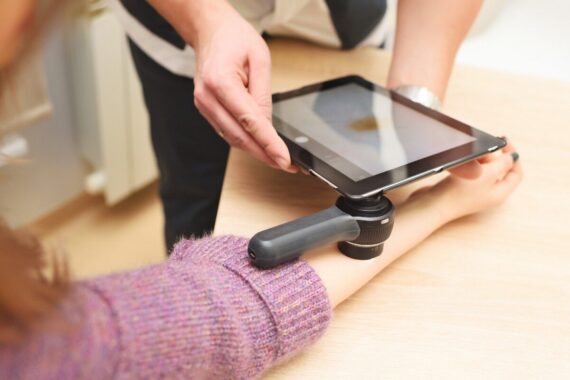AI skin cancer triage given conditional green light by NICE

An AI-powered system for detecting potential skin cancer has been approved by NICE for use on the NHS for three years while further evidence on its effectiveness is collected.
The technology can be used as part of the triage process within the urgent referral pathway and could ‘significantly reduce’ waiting times, NICE said.
Deep Ensemble for Recognition of Malignancy (DERM) can be incorporated into teledermatology services in the NHS to allow more evidence to be collected on its use, the committee ruled.
But as part of the recommendations, a healthcare professional must review all cases referred with black or brown skin to ensure accuracy of the system.
And regular monitoring must be done of the DERM AI system whenever it is being used to triage patients, NICE added.
Dermatology services in the UK receive 1.2 million referrals a year from primary care, the committee noted, with about 60% of those being urgent skin cancer referrals.
Of those 6% are ultimately confirmed to be cancer. A national shortage of consultant dermatologists and long waiting lists has led to delays in diagnosis, NICE added.
DERM analyses images taken from a smartphone with a dermoscopic lens attachment to assess and triage skin lesions, potentially redirecting benign cases to non-urgent pathways.
After a patient has been referred from primary care into a teledermatology service the skin lesion can then be remotely assessed, diagnosed, or monitored without requiring a physical in-person visit.
An algorithm compares the images from the referral to its bank of images for known skin conditions to identify which need to be seen by a dermatologist.
Early evidence suggests automated use of DERM could approximately halve the number of referrals within the urgent skin cancer pathway compared to using teledermatology alone.
Patients whose lesions are identified as benign by DERM will be discharged from the urgent pathway and receive their results with written advice from a healthcare professional.
NICE will review the evidence generated after the three-year period.
Dr Anastasia Chalkidou, healthtech programme director at NICE, said: ‘DERM has shown promising results in its ability to accurately distinguish between cancerous and non-cancerous skin lesions, with evidence suggesting it could halve the number of referrals to dermatologists within the urgent skin cancer pathway while maintaining patient safety.
‘Our evaluation shows this technology maintains diagnostic accuracy while reducing the burden on specialist dermatology services. By implementing this system within existing pathways, we can ensure patients get the right care more quickly.’
Visit Pulse Reference for details on 140 symptoms, including easily searchable symptoms and categories, offering you a free platform to check symptoms and receive potential diagnoses during consultations.
Related Articles
READERS' COMMENTS [1]
Please note, only GPs are permitted to add comments to articles













working now in dermatology after a full career as a GP I can see the attractiveness of AI in both fields and patients are having such a tough time trying to speak to someone knowledgable and kind that they will love interacting with AI. We are signing our own death warrant by being so hard to reach.